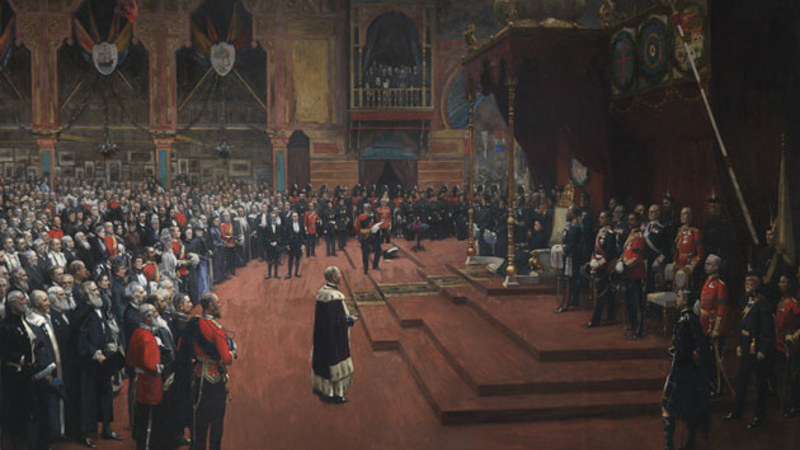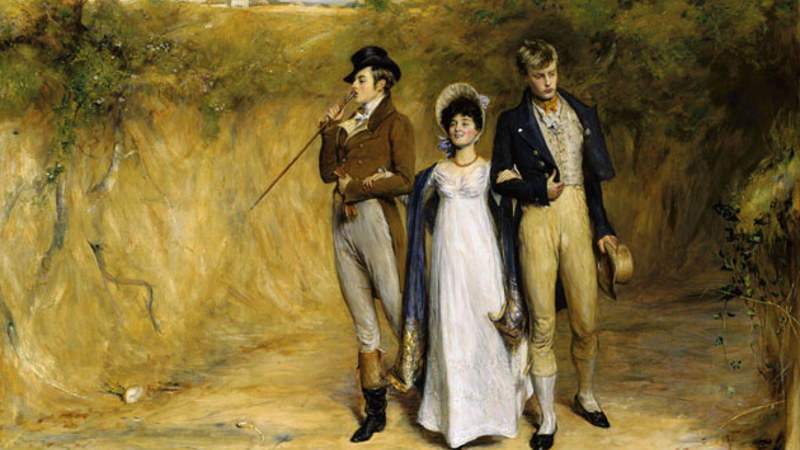John Muir of Deanston

State Visit of her Majesty, Queen Victoria to the Glasgow International Exhibition, 1888
John Lavery, 1890
Currently on display at Kelvingrove Art Gallery and Museum, in the stairwell at the south-west corner of the Centre Hall leading up to Glasgow – City of Empire on the South Balcony
Museum accession number 710
Image © CSG CIC Glasgow Museums Collection
26 June 2024
As part of Glasgow - City of Empire, a new permanent display examining the legacies of colonialism and how they have shaped our city, we highlighted some of the individuals shown in John Lavery’s painting of Queen Victoria’s visit to the 1888 International Exhibition of Industry, Science and Art at Kelvingrove Park in Glasgow. Several of the people present during Queen Victoria’s visit held strong connections to imperialism. Their presence reflects the standing and status that many gained through the British Empire.
One of those in attendance was John Muir of Deanston. In 1888 Muir was in sole control of the Glasgow-based James Finlay & Co., one of the world’s largest companies, which made huge profits across the British Empire through tea, textiles and cotton. Muir convened the India and Ceylon (Sri Lanka) section of the 1888 exhibition and made a personal donation to it of £15,000 (more than £9 million today, in terms of relative output worth). The life of Muir and the history of James Finlay & Co. offer an insight into the ways many Scottish firms and individuals made fortunes through the empire.

John Muir of Deanston
John Lavery, 1889
Museum accession number 2004
Image © CSG CIC Glasgow Museums Collection
John Muir was born in Glasgow in 1828. His father was a steel merchant, and his mother was a descendant of James Finlay, the founder of James Finlay & Co. In 1860 he married Margaret Morrison Kay, the daughter of Alexander Kay, who was a senior partner in James Finlay & Co. The couple initially lived at 6 Park Gardens in the West End of Glasgow near Kelvingrove Park. In 1861 Muir was appointed as a junior partner at Finlays.
The year 1861 was an uncertain time for the firm. Importing raw cotton and cotton manufacturing had been important to its success since it was founded in 1750. By the late 1700s cotton had become essential to the economy of Glasgow and Scotland, with thousands of tons of cotton being imported to the Clyde on an annual basis. This led to an increase in cotton spinning mills across Glasgow and the West of Scotland, which provided employment, often in poor conditions, for thousands of workers. This cotton was mainly produced by enslaved African people − 90 per cent of cotton imported to Scotland between 1770 and 1824 came from either North America or the Caribbean. James Finlay & Co. and other companies made a fortune through colonial exploitation and enslavement. But their profits were harmed when the American Civil War (1861–65) impacted on the importation of cotton into the UK. (See other blogs on this site, including Glasgow’s role in the American Civil War by John Messner, Curator of Transport and Technology, for more on this topic.)
In search of alternative sources of cotton, James Finlay & Co. opened offices in Bombay and Calcutta (now Mumbai and Kolkata), India. The company also began to invest in insurance, shipbuilding and tea production. At the same time as the company expanded into the Indian subcontinent, John Muir’s standing within the company grew.
By 1883 Muir had gained sole control of the firm, which now employed 70,000 workers across the Indian subcontinent. He was deeply unpopular amongst the workforce due to the low pay and harsh conditions experienced on many of the company’s tea plantations.

Door frame with two recessed doors, part of the Indian Pavilion at the 1888 Glasgow International Exhibition, 1888
The doors are partly made from recycled crates that are marked with the name James Finlay & Co.
Currently on display at Kelvingrove Art Gallery and Museum, in Glasgow – City of Empire
Museum accession number 1888.109.ke
Image © CSG CIC Glasgow Museums Collection
From 1889 to 1892 Muir was the Lord Provost of Glasgow. By this time, he was living at Deanston House in Perthshire, which he had moved to in 1873 and enlarged in 1881. The house overlooked Deanston Cotton Mill, which was purchased by James Finlay & Co. in 1808 and, like the firm, was deeply connected to slavery through the cotton that was manufactured there. Muir also purchased and collected artworks, including the painting Two Strings to Her Bow by John Pettie, which he gave to Glasgow Life Museums.

Two Strings to Her Bow
John Pettie, 1887
Currently on display in Kelvingrove Art Gallery and Museum, Every Picture Tells a Story gallery
Museum accession number 663
Image © CSG CIC Glasgow Museums Collection
John Muir died in 1903, leaving a fortune of £862,802 (£426 million today, relative output worth). Muir is a key figure in not only the history of Glasgow and Scotland, but also the history of several nations with a legacy of colonisation by the British Empire, including India, Pakistan, Sri Lanka and Bangladesh. His life and legacy are a reminder of the significant global influence and impact possible for Glasgow-based companies and individuals operating within the British Empire.
Nelson Cummins,
Curator (Legacies of Slavery and Empire)
